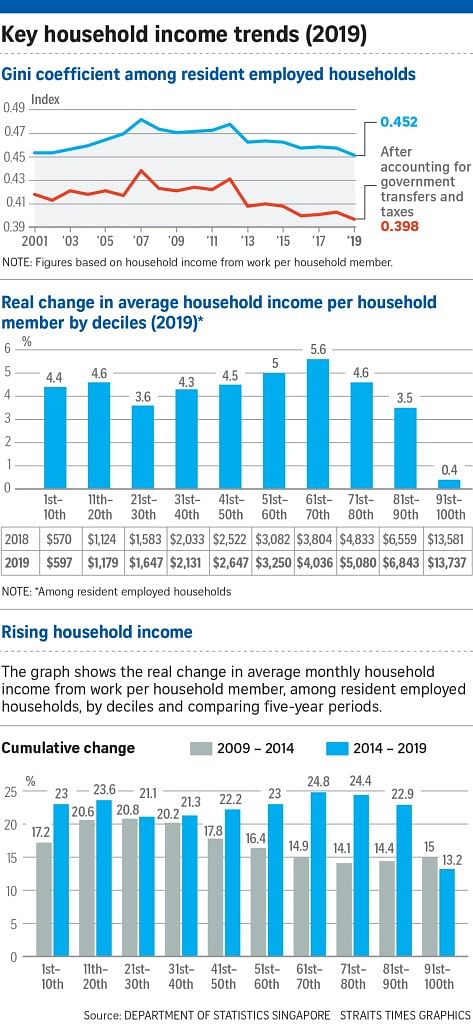The top 10 per cent of families in Singapore saw their average household income rise by just 0.4 per cent last year - much lower than the bulk of households here, which saw growth of between 3.5 per cent and 5.6 per cent.
These figures, released yesterday in an annual report by the Department of Statistics, describe the real growth in average household income from work per household member, in families with at least one working member.
Experts said the results published in the report - which also found that income inequality in Singapore had fallen to its lowest in nearly two decades - were due to the Government's efforts to boost the income of low-wage earners.
Meanwhile, the slower income growth for top income earners might be blamed on the sluggish economy. Singapore's economy grew by 0.7 per cent year on year in 2019, down from 3.1 per cent in 2018.
Mr Song Seng Wun, an economist at CIMB Private Banking, said the trade war could have had an indirect impact on those in the top income bracket.
"If we look at civil servants' annual wage increments or bonuses, it's tied to GDP (gross domestic product). And GDP performance is tied to whether we get trade friction..."
He noted that the relatively higher growth rates in the middle-income group could partly be the result of the Government encouraging businesses to hire more locals.
Some suggested there may be other reasons for growth in income, such as falling household sizes.
Last year, the average household size among resident employed households fell to 3.36 people, from 3.44 in 2018 - which could translate to a higher household income per member.
Associate professor of economics Walter Theseira, of the Singapore University of Social Sciences, added that most households, except for those in the highest income brackets, have seen an increase in the average number of working members.
"Among the very top decile of household income earners, you actually see that the average number of people in the household working has actually gone down over the last 10 years. That, by itself, moderates somewhat the rise in household income inequality."
Noting that in the West, some extremely well-off households have only one working member because they do not need the extra income - something that has been described as the "trophy wife (or husband) phenomenon - he said: "I think high-income earners in Singapore question whether it is really necessary for both members to work, especially when their children are in certain critical ages."
In yesterday's report, "household income from work" includes Central Provident Fund contributions from employers, but excludes income from sources such as dividends and rent.
"It would be surprising," added Prof Theseira, "if you looked at individuals in the top brackets, and found that the (total) income really had slowed. Because that would be a strong counterpoint to the trend we have observed over the past couple of decades - that more and more of the returns go to them.
"A broader concern is whether there have been more and more opportunities for high-income earners to shift their income over to capital - which is a lot harder for countries to capture and monitor, compared with work income."
Mr Song added that the bottom 10 per cent, which last year had an average monthly household income of $597 per household member, might have seen more pronounced growth as "the base they are coming from is much lower".
DBS Bank senior economist Irvin Seah noted that the higher income rates for lower-to middle-income groups could be signs that efforts to upskill workers and enhance productivity have borne fruit.
He also acknowledged that much of the report deals with families with at least one working member - forming 86.8 per cent of households here.
This excludes those whose sole breadwinner has been retrenched, or where all members are retired and, possibly, elderly and poor.
So, while the reported fall in levels of income inequality is encouraging, "it does not show the full picture".



